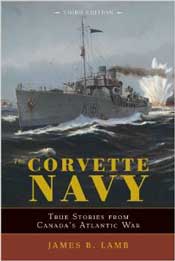In his book The Corvette Navy – True Stories from Canada’s Atlantic War, James B. Lamb tells the story of Percy, his ship’s groundhog mascot (the vessel was, possibly, HMCS CAMROSE).
The following excerpt describes Percy’s endearing qualities and several of his escapades –
“In downtown Toronto I had seen this incredible groundhog, following along at the heels of its owner through all the crowds of a noonday Yonge Street lunch-hour, and knew instantly that this was for us.”
“This particular animal, it transpired, belonged to Mr. Skinner, who ran a famous pet shop in the old Arcade. She was not for sale, but she had a litter of pups back in the store and I bought one on the spot, a toothy little devil no bigger than a squirrel, and arranged for him to be shipped out to us in a box packed with cabbage leaves to sustain his considerable appetite.
“Percy our ship’s groundhog mascot quickly settled into a comfortable shipboard routine. I had been deputized to bring back a mascot, preferably a parrot, for our refitting ship while on leave in Toronto. We were currently under the spell of a consort’s parrot, which used to shuffle about the rim of the wardroom table and screech ‘Where’s father?’ followed by a sotto voce muttering…
“He arrived in Newfyjohn [Editor’s note – ‘Newfyjohn’ is naval slang for St. John’s, Newfoundland] in splendid shape, and popped out of his box and sat up on the magazine hatch in the wardroom flat and ate his first sea-biscuit, watched by an admiring throng.
“He was an ideal mascot; quickly housebroken to a sandbox, which he used like a cat, he dearly loved to play. He went about dragging an old glove, which he offered to everyone in the hope that they would play with him, trying to take it from him as one does with a puppy, while he grunted in mimic fury. He became an adept climber, and would whistle up the wardroom curtain like a cat, or shinny up a voice-pipe if one was foolish enough to take him on the bridge for company, as I was sometimes known to do.
“Percy was supposed to live in the cabin flat aft, or in the wardroom, since he was grossly over-fed if he ventured into the galley or the fo’c’sle; he knew this well enough, but he was as cunning as a fox.
“From the bridge wing, I would see his furry head appear over the coaming of the after flat; two beady eyes would check that the coast was clear.
“Then, waiting for the out-board roll – for he was as sea-wise as any shell-backed sailor and knew that the waist would clear itself of water as the ship rolled outward – he would leap out onto the wet deck and scuttle like mad for the galley, reaching the sanctuary of its lower step before the next sea came toppling inboard.
“Percy survived many vicissitudes – his seagoing diet was notably short of the green grass staple of his shoreside chums – but his most notable triumph of adjustment occurred when he grew overly curious while spying on the engineer’s storekeeper and fell down the storeroom hatch. He broke both his big front upper teeth on the steel deck; after vainly gumming his usual cabbage leaf that night, he huddled miserably in a corner in a snit. Nor would he eat the long strips of leaf we cut up for him; we thought he was doomed.
“But a remarkable thing happened. His lower teeth, now unopposed by the dominant upper teeth, grew with incredible rapidity, and in no time Percy was nibbling away, as good as new – but now he was undershot, instead of overshot, and so he remained.”



 CFB Esquimalt Naval and Military Museum
CFB Esquimalt Naval and Military Museum CFB Esquimalt Naval and Military Museum
CFB Esquimalt Naval and Military Museum CFB Esquimalt Naval and Military Museum
CFB Esquimalt Naval and Military Museum